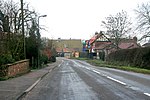Bassingthorpe

Bassingthorpe is a small village in the civil parish of Bitchfield and Bassingthorpe, in the South Kesteven district of Lincolnshire, England. It is 5 miles (8 km) south from Grantham, and on a C class road between the B6403 to the west and the B1176 to the east. In 1921 the parish had a population of 78. On 1 April 1931 the parish was abolished and merged with Bitchfield to form "Bitchfield and Bassingthorpe".The village contains 4 houses and a Grade I listed church dedicated to St Thomas. The ecclesiastical parish is part of The North Beltisloe Group of parishes, of the Deanery of Beltisloe in the Diocese of Lincoln. From 2006 to 2011 the incumbent was Rev Richard Ireson.
Excerpt from the Wikipedia article Bassingthorpe (License: CC BY-SA 3.0, Authors, Images).Bassingthorpe
Bassingthorpe Road, South Kesteven Bitchfield and Bassingthorpe
Geographical coordinates (GPS) Address Nearby Places Show on map
Geographical coordinates (GPS)
| Latitude | Longitude |
|---|---|
| N 52.845911 ° | E -0.565966 ° |
Address
Bassingthorpe Road
Bassingthorpe Road
NG33 4EB South Kesteven, Bitchfield and Bassingthorpe
England, United Kingdom
Open on Google Maps









